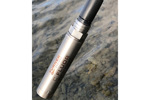WASTEWATER INSTRUMENTATION RESOURCES
-
To move forward with long-overdue infrastructure upgrades, Nodra AB needed a wastewater bypass solution capable of lifting up to 3,000 liters per second into its Slottshagens treatment plant. Xylem’s Rental Solutions team set up a turnkey wastewater bypass station in a little over three weeks.
-
Technology like advanced process control systems can streamline operations, create opportunities to lower costs and emissions, and ensure effluent quality meets the highest standards. Research also indicates that implementing an appropriate control strategy can help reduce N2O emissions.
-
Strategic flow monitoring helps wastewater utilities curb overflows, cut costs, and safeguard public health by turning accurate data into proactive action.
-
Wastewater plants are made up of a series of interconnected processes, each one dependent on accurate data. Turbine flow meters can be installed at several stages to provide operators with real-time, trustworthy flow information.
-
"Potential" is in the name. Here's what wastewater managers should know about both the benefits and challenges of ORP as an agent of process control.
-
In order to improve the treatment performance (because of the continued cost to maintain compliance), and ensure that it would eventually have the treatment capacity to meet future population growth equivalent of up to 225,000, Swansea WwTW was in need of an equipment upgrade.
-
The U.S. PFAS analytical instrumentation market is poised for strong expansion, with a projected CAGR exceeding 20% over the next seven years, according to a new report. Key drivers in the market include rising concerns over increasing risks associated with PFAS exposure, the U.S. EPA's federal rule on drinking water, and investments to boost testing and treating PFAS in water.
-
Aided by "soft sensors," machine learning is revolutionizing monitoring and powering real-time predictions.
-
Remote wastewater services are available to monitor e-waste contamination in the global water supply. This article explains the problem, details its scope and threat, and presents devices for the monitoring of e-waste in water.
-
Hmmm … what’s new for 2025? That's asked with a hint of knowing sarcasm, as the incoming presidential administration promises to disrupt the status quo. The change in direction for environmental policy, including impacts on regulations as well as traditional and human infrastructure, has yet to fully reveal itself.
WASTEWATER INSTRUMENTATION SOLUTIONS
-
DPS5000 SDI-12 Digital Pressure Sensing Platform
The DPS5000 SDI-12 from Druck, part of the UNIK5000 family, offers integrated digital electronics to enhance the performance level of the UNIK 5000 Pressure Sensing Platform to levels unmatched by traditional analogue sensors. It uses SDI-12 protocol, over which fully compensated readings of pressure and temperature are sent, as well as control of many functions of the device.
-
DPS5000 I2C Digital Pressure Sensing Platform
The DPS5000 I2C from Druck, part of the UNIK5000 family, offers integrated digital electronics to enhance the performance level of the UNIK 5000 Pressure Sensing Platform to levels unmatched by traditional analogue sensors. It features an I2C digital interface, over which fully compensated readings of pressure and temperature are sent, as well as control of many functions of the device.
-
RPS/DPS 8000 Series (TERPS)
The RPS/DPS 8000 series incorporate the exciting new TERPS technology. TERPS is a resonant silicon pressure sensor technology platform that provides an order of magnitude greater accuracy and stability than current pressure measurement technologies.
-
UNIK5000 Series Pressure Sensing Platform
The new UNIK 5000 is a high-performance configurable solution to pressure measurement. The use of micromachined silicon technology and analogue circuitry enables best-in-class performance for stability, low power, and frequency response. The new platform enables you to easily build up your own sensor to match your precise needs. This high-performance, configurable solution to pressure measurement employs modular design and lean manufacturing techniques.
-
C-FLUOR Probes Now Offer Digital Output
C-FLUOR probes are sensitive single-wavelength in situ fluorescence and turbidity instruments that are now available with a Digital Output option.















